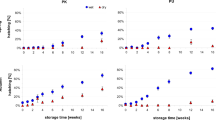Summary
-
1.
Time of day of larval release by ovigerous females of the terrestrial crabSesarma haematocheir collected from the Kasaoka population (Okayama Prefecture, Japan) was examined using a method which detected the decrease in transmission of an infrared beam due to the release of zoea larvae.
-
2.
Recordings under non-tidal and continuously dark (DD) conditions demonstrated a freerunning tidal rhythm of larval release. The timing of release approximately coincided with the times of nocturnal high water occurring in the field during the first 10 days. Then followed a ‘phase jump’, about 8 h where release time advanced to the conjugated high water. Correlation of release time with this high-water curve was reduced for the next 10 days, accompanied by desynchronization among individuals.
-
3.
Artificial 24-h light-dark cycles (LD) caused a delay or advance phase-shift of this free-running rhythm after a series of transients. Under these conditions individuals did not become strongly desynchronized, and the new release timing was related to the phase difference between the natural and artificial light regimes, closely dependent on the time lag between sunset and light-off. This indicates that the onset of darkness is one of the environmental Zeitgebers primarily concerned in controlling the phase of theSesarma tidal rhythm.
-
4.
An artificial tidal cycle simulating ebb and flood of tides in the habitat of crabs could not entrain the circa-tidal rhythm ofSesarma. Simulated sounds of the surf also failed to shift the phase of the ongoing rhythm.
-
5.
An experiment with short photoperiods (LD 3∶21) gave no indication of a bimodal tidal component (interval of about 12.4 h) in theSesarma circa-tidal rhythm; the underlying component was clearly ‘unimodal’ (period of about 24.8 h).
-
6.
Possible explanations are given for the circatidal rhythm ofSesarma which free-runs through the night at semimonthly intervals, and for its phase-shift caused by the 24-h light-dark cycles.
Similar content being viewed by others
References
Barnwell FH (1966) Daily and tidal patterns of activity in individual fiddler crab (genusUca) from the Woods Hole region. Biol Bull 130:1–17
Brown FA Jr, Fingerman M, Sandeen MI, Webb HM (1953) Persistent diurnal and tidal rhythms of color change in the fiddler crab,Uca pugnax. J Exp Zool 123:29–60
Chandrashekaran MK (1965) Persistent tidal and diurnal rhythms of locomotory activity and oxygen consumption inEmerita asiatica (M.-Edw.). Z Vergl Physiol 50:137–150
Enright JT (1965) Entrainment of a tidal rhythm. Science 147:864–867
Enright JT (1972) A virtuoso isopod. Circa-lunar rhythms and their tidal fine structure. J Comp Physiol 77:141–162
Fingerman M (1955) Persistent daily and tidal rhythms of color change inCallinectes sapidus. Biol Bull 109:255–264
Gibson RN (1971) Factors affecting the rhythmic activity ofBlennius pholis L. (Teleostei). Anim Behav 19:336–343
Klapow LA (1972) Natural and artificial rephasing of a tidal rhythm. J Comp Physiol 79:233–258
Morgan E (1965) The activity rhythm of the amphipodCorophium volutator (Pallas) and its possible relationship to changes in hydrostatic pressure associated with the tides. J Anim Ecol 34:731–746
Naylor E (1958) Tidal and diurnal rhythms of locomotory activity inCarcinus maenas (L.). J Exp Biol 35:602–610
Naylor E (1960) Locomotory rhythms inCarcinus maenas (L.) from non-tidal conditions. J Exp Biol 37:481–488
Naylor E (1976) Rhythmic behaviour and reproduction in marine animals. In: Newell RC (ed) Adaptation to environment; essays on the physiology of marine animals. Butterworths, London, pp 393–429
Palmer JD (1967) Daily and tidal components in the persistent rhythmic activity of the crab,Sesarma. Nature 215:64–66
Palmer JD, Round FE (1967) Persistent, vertical-migration rhythms in benthic microflora. VI. The tidal and diurnal nature of the rhythm in the diatomHantzschia virgata. Biol Bull 132:44–55
Pittendrigh CS (1960) Circadian rhythms and the circadian organization of living systems. Cold Spring Harbor Symp Quant Biol 25:159–184
Pittendrigh CS, Bruce VG (1959) Daily rhythms as coupled oscillator systems and their relation to thermoperiodism and photoperiodism. In: Withrow RB (ed) Photoperiodism and related phenomena in plants and animals. American Association for the Advancement of Science, Washington, pp 475–505
Pittendrigh CS, Bruce VG, Kaus P (1958) On the significance of transients in daily rhythms. Proc Natl Acad Sci USA 44:965–973
Saigusa M (1980) Entrainment of a semilunar rhythm by a simulated moonlight cycle in the terrestrial crab,Sesarma haematocheir. Oecologia 46:38–44
Saigusa M (1981) Adaptive significance of a semilunar rhythm in the terrestrial crabSesarma. Biol Bull 160:311–321
Saigusa M (1982) Larval release rhythm coinciding with solar day and tidal cycles in the terrestrial crabSesarma — harmony with the semilunar timing and its adaptive significance. Biol Bull 162:371–386
Saigusa M (1985) Tidal timing of larval release activity in nontidal environment. Jpn J Ecol 35:243–251
Webb HM (1976) Interactions of daily and tidal rhythms. In: DeCoursey PJ (ed) Biological rhythms in the marine environment. University of South Carolina Press, Columbia, pp 129–135
Author information
Authors and Affiliations
Rights and permissions
About this article
Cite this article
Saigusa, M. The circa-tidal rhythm of larval release in the incubating crabSesarma . J. Comp. Physiol. 159, 21–31 (1986). https://doi.org/10.1007/BF00612492
Accepted:
Issue Date:
DOI: https://doi.org/10.1007/BF00612492




